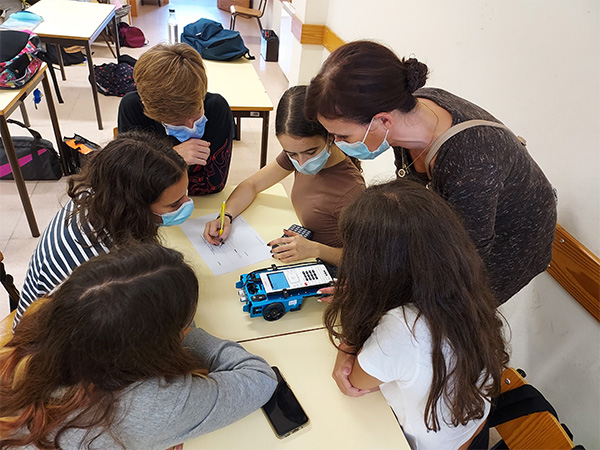Smart Irrigation With the TI-Nspire™ CX Ecosystem: “Students See That Mathematics Is Actually Very Useful”
The motivation and enthusiasm of the students at Molelos Secondary School in Tondela, Portugal, were the driving forces behind the Smart Irrigation project using the TI-Nspire™ CX Ecosystem. But it was maths teacher Olga Pestana who put the wheels in motion.
“I started with some small projects to get the students interested,” Olga Pestana, who has been using the TI-Innovator™ Rover since 2020, recalled. “They were writing simple scripts to draw polygons, analyse angles and apply the Pythagorean theorem.”
The seed for the Smart Irrigation project was sown after a workshop on Python
In the 2020–2021 school year, Pestana asked fellow teacher Alexandre Gomes to come and do a workshop on the Python programming language for secondary schools. This was how the first seed was sown for a project that would be brought to fruition by enthusiastic year 11 students at Molelos Secondary School. “That was when we were introduced to the irrigation kit. I noticed that the students were very enthusiastic about the idea of making the irrigation project work in the school’s green spaces,” Pestana recalled. Getting to know about other projects and understanding how they could be applied helped the process. “They became very excited when Gomes said he and his students had won a trip to NASA.”
With the green light from the board and the support of the Texas Instruments Loan Program, the project went ahead in September 2021.
Along the way, other curriculum disciplines joined the project
With a seedbed, the irrigation kit, the TI-Innovator™ Hub, TI-Innovator™ Rover and the TI-Nspire™ CX II-T graphing calculator software, some of the main elements were in place to make the project a success. But it was the presence of teacher Pestana and her colleagues from other disciplines which made the project a truly multidisciplinary one.
“I spent a total of eight lessons setting up the project from start to finish, and this was complemented by a number of classes taught by colleagues in biology, citizenship, philosophy and English,” she said.
An interdisciplinary project is different, Pestana said: “The approach is more effective, for one. You need less time and cooperation between the different disciplines, and it brings better results. The students are very motivated. They want to become involved and there is a healthy interaction. Technology in the classroom really makes a difference.”
At every stage, the enthusiasm of the students buoyed the project along
“The basic problem was the drought in Africa — the students did research and wrote assignments for each of the subjects we looked at,” Pestana said. “In maths, the class was divided into small groups and the students started by writing the programs in TI-Basic on the calculator. Some worked on the light sensors, others on the water pump, the air temperature and humidity sensors. That was the start,” Pestana said.
Then the testing stage arrived, and that included putting the water pump through its paces. “It was very interesting for the students to see the various speeds of the water and measure the flow capacity.”
To Pestana, it made sense to put into practice what she herself had learned at the same time. “I started to translate the small scripts from TI-Basic into Python, which is easy and accessible for everyone, especially for students.”
She has no doubt about what it is that keeps the students wanting to learn this type of programming language. “It’s the surprise factor. It’s the first time they see concrete results and understand that mathematics is actually very useful,” she said.

A look into the future and technology
The Smart Irrigation project was a resounding success. More projects are in the pipeline, and others are being considered. “Why not make the Rover work for us?” asked Pestana, who said her students are challenging her, but in a good way.
“By using the calculator in the classroom, students get the opportunity to work with technology and solve problems in a way that appeals to them more than using pencil and paper. If we want to make progress, the use of calculators in the classroom should be encouraged. The new professions demand it.”
Texas Instruments has enabled students to start working with technology and programming in a simple way in the classroom, and that, Pestana said, is a great advantage. “In Portugal, a mathematics programme will be introduced that is aimed at computational thinking, and I think we are already a bit ahead in that respect," concluded Pestana, who is considering starting a robotics laboratory at the school.
Check out these other blogs on teacher projects:
